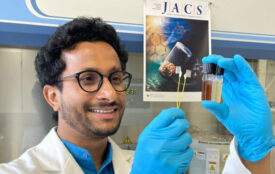Hail damage to solar systems – who pays?
Hail damage to photovoltaic modules is difficult to detect and difficult to prove.
Insurance companies are therefore not always obliged to pay for such losses. “FLOIS” is a new, award-winning analytical method developed by the Institute for Solar Energy Research (ISFH) in Hamelin and sheds light on the dark solar environment.
In many cases, it is not yet clear whether damage to photovoltaic modules has been caused by hail or other external influences. Cracks in the solar cells influence the efficiency of the photovoltaic modules and can well occur due to storms. However, they are sometimes not immediately recognisable after hail, because hailstones, which sometimes reach diameters of more than five centimetres and more, do not necessarily cause visible damage to the front glass. However, small cracks in the solar cells can occur, which reduce the output of the solar cell over a longer period of time. The thinner the front glass and frame, the higher the risk of damage. And if the owner or the operator of such an installation would like to make use of his insurance, their experts often come to completely different assessments: The causality of the damage caused by hail is not verifiable, there could also be installation or transport damage, ergo the insurance company is released from the liability obligation. And the burden of proof always lies with the owner of the solar system.
This grey area in the assessment could now belong to history, because ISFH has developed a procedure with which the proof of the cause and the time of the damage occurrence can be determined. This process was honoured with the Innovation Award at the “32nd Symposium for Photovoltaic Solar Energy” in Bad Staffelstein on 9 March.
The new method is simply called “FLOIS”: Fluorescence outdoor inspection system. “FLOIS is largely weather-independent compared to other inspection systems, such as electroluminescence and thermography methods,” explains Dr. Marc Köntges, who co-developed the method.
And how does that work? A black canopy is placed on the solar module, under which LEDs illuminate the module with UV light. A camera then records the fluorescence of the module. Where there are cracks, no fluorescence is visible, because the cell is defective there.
With FLOIS, this can even be done during the day and really quickly: up to 200 modules can be examined in one hour. FLOIS also shows which cells are active and which are not. Solar cells with cracks that lead to a reduction in yield appear brighter than intact cells on the UV fluorescence images. In particular, the technique makes hailstorm damage distinguishable from other causes of damage due to the different fluorescence intensities in the area of the cell cracks. The electroluminescence technology that is commonly used, on the other hand, can only be used at night because during the daytime the sunlight interferes and is not able to clearly distinguish hail damage from transport and installation errors.








